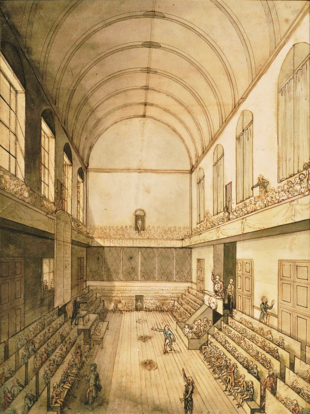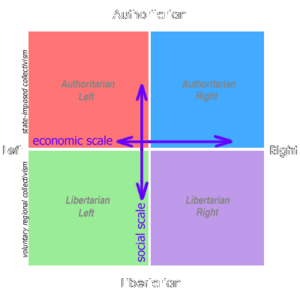Political spectrum: Difference between revisions
SociusVenger (talk | contribs) m (Added image.) |
SociusVenger (talk | contribs) m (Corrected formatting.) |
||
| Line 3: | Line 3: | ||
The left-right spectrum, by far the oldest and best-known political spectrum, is said to have originated with the seating arrangements of the French National Assembly{{cn}} during the [[French Revolution|Revolutionary era]] (1789–99). In order to prevent the heated fights which had characterized the early Assembly, delegates naturally came to seat themselves with groups similar to their own persuasion, with opponents of the monarchy on the left and restorationists on the right. This arrangement persists in most representative political bodies in the world today. | The left-right spectrum, by far the oldest and best-known political spectrum, is said to have originated with the seating arrangements of the French National Assembly{{cn}} during the [[French Revolution|Revolutionary era]] (1789–99). In order to prevent the heated fights which had characterized the early Assembly, delegates naturally came to seat themselves with groups similar to their own persuasion, with opponents of the monarchy on the left and restorationists on the right. This arrangement persists in most representative political bodies in the world today. | ||
The oldest political self-identifications of [[bourgeois society]], from [[anarchism]], [[socialism]], and [[communism]] to [[reaction]]ism and [[conservatism]], typically agreed on which wing each group belonged to. However, since the mid-20th century, [[liberal]] | The oldest political self-identifications of [[bourgeois society]], from [[anarchism]], [[socialism]], and [[communism]] to [[reaction]]ism and [[conservatism]], typically agreed on which wing each group belonged to. However, since the mid-20th century, [[liberal]] responses to [[fascism]] and the insurgent communist movement introduced concepts such as "[[authoritarianism]]" as an element of [[Cold War]] propaganda, and many commentators, especially [[right-libertarian]]s, have since attempted to incorporate some form of authoritarianism into a one- or two- dimensional spectrum, or '''"compass"''' which conflates right-wing authoritarianism with the tendencies of [[Marxist]]s, [[Leninist]]s, and especially [[Marxist–Leninist|Marxist–Leninists]]. However, some [[anarchist]]s maintain the importance of authoritarianism as a concept and may support some critiques of [[state socialism]] or the [[dictatorship of the proletariat]], among other Marxist concepts. | ||
In any case, leftists vary on their interpretation not only of "authoritarian" politics but of "left" and "right" as useful concepts for political organizing. Topics of discussion include the usefulness of "left-wing" [[radlib]]s, [[social democrat]]s, and [[democratic socialist]]s to leftist organizing; the importance of [[left unity]] | In any case, leftists vary on their interpretation not only of "authoritarian" politics but of "left" and "right" as useful concepts for political organizing. Topics of discussion include the usefulness of "left-wing" [[radlib|radical liberal]]s, [[social democrat]]s, and [[democratic socialist]]s to leftist organizing; the importance of [[left unity]]. | ||
== Left and right == | == Left and right == | ||
| Line 13: | Line 13: | ||
== Variations == | == Variations == | ||
Tim Cornelis' | Tim Cornelis'{{who}}{{cn}} interpretation of the political spectrum intertwined with historical development. This spectrum is not universally accepted in Marxism. | ||
=== Traditional linear spectrum === | === Traditional linear spectrum === | ||
| Line 26: | Line 26: | ||
The 'One True Spectrum' is a spectrum originating on the Internet from [[minarchist]] and other extreme [[right-libertarian]] circles. It has no academic or theoretical underpinnings and is based on grave misconceptions about the nature of politics. The spectrum is biased in favour of minarchism and limited government construing it in such a way to make it appear the most sensible. | The 'One True Spectrum' is a spectrum originating on the Internet from [[minarchist]] and other extreme [[right-libertarian]] circles. It has no academic or theoretical underpinnings and is based on grave misconceptions about the nature of politics. The spectrum is biased in favour of minarchism and limited government construing it in such a way to make it appear the most sensible. | ||
On the far-left there | On the far-left there is autocracy or monarchy, which includes [[Monarchism|monarchism]], [[fascism]], [[communism]], [[socialism]], and [[nationalism]]. On the moderate left we find [[corporatism]] (a misuse of the word corporatism, implying it is associated with Big Business). In the centre, the spectrum places [[Democracy|democracy]], which supposedly inherently leads to larger government. On the centre- or moderate right it places '[[republic]]' (based on a misuse of republic) based on rule of law and [[Constitutionalism|constitutionalism]] and limited government. | ||
[[File:Polcompassaxes.png|thumb|Political compass as employ by politicalcompass.org. ]] | [[File:Polcompassaxes.png|thumb|Political compass as employ by politicalcompass.org. ]] | ||
According to this spectrum, [[Communism|communism]] (being stateless) ought to be placed on the far-right and [[fascism]] on the far-left. | According to this spectrum, [[Communism|communism]] (being stateless) ought to be placed on the far-right and [[fascism]] on the far-left. | ||
| Line 39: | Line 39: | ||
===Radicalism and reaction=== | ===Radicalism and reaction=== | ||
<!--[[File:Radicalism and Reaction.jpg|frame|right]]--> | <!--[[File:Radicalism and Reaction.jpg|frame|right]]--> | ||
Radicalism is currently employed to signify extremism. Historically, radicalism was inherently left-wing and the right-wing equivalent of radical was reactionary. This particular spectrum went 'radical - progressive - conservative - reactionary'. | Radicalism is currently employed to signify extremism. Historically, radicalism was inherently left-wing and the right-wing equivalent of radical was reactionary. This particular spectrum went 'radical - progressive - conservative - reactionary'.{{Citation needed|date=September 2023}} | ||
== References == | == References == | ||
<references /> | <references /> | ||
[[Category:Political science]] | [[Category:Political science]] | ||
Revision as of 19:52, 2 September 2023
A political spectrum is a system of classifying different political positions upon one or more geometric axes that represent independent political "dimensions".
The left-right spectrum, by far the oldest and best-known political spectrum, is said to have originated with the seating arrangements of the French National Assembly[citation needed] during the Revolutionary era (1789–99). In order to prevent the heated fights which had characterized the early Assembly, delegates naturally came to seat themselves with groups similar to their own persuasion, with opponents of the monarchy on the left and restorationists on the right. This arrangement persists in most representative political bodies in the world today.
The oldest political self-identifications of bourgeois society, from anarchism, socialism, and communism to reactionism and conservatism, typically agreed on which wing each group belonged to. However, since the mid-20th century, liberal responses to fascism and the insurgent communist movement introduced concepts such as "authoritarianism" as an element of Cold War propaganda, and many commentators, especially right-libertarians, have since attempted to incorporate some form of authoritarianism into a one- or two- dimensional spectrum, or "compass" which conflates right-wing authoritarianism with the tendencies of Marxists, Leninists, and especially Marxist–Leninists. However, some anarchists maintain the importance of authoritarianism as a concept and may support some critiques of state socialism or the dictatorship of the proletariat, among other Marxist concepts.
In any case, leftists vary on their interpretation not only of "authoritarian" politics but of "left" and "right" as useful concepts for political organizing. Topics of discussion include the usefulness of "left-wing" radical liberals, social democrats, and democratic socialists to leftist organizing; the importance of left unity.
Left and right
Various attempts exist to define the difference between "left" and "right".
Liberal analysis
Features
Variations
Tim Cornelis'[who?][citation needed] interpretation of the political spectrum intertwined with historical development. This spectrum is not universally accepted in Marxism.
Traditional linear spectrum
The traditional left-right linear spectrum can indicate various factors, or a combination of these. For instance, one common factor is social equality. The more social equality is pursued, the more to the left the political idea in question is said to be under this classification. Thus, anarchism and communism are placed on the far-left of the political spectrum while fascism, given its extreme social stratification, is placed on the far-right.
Horseshoe theory
The horseshoe theory in political science asserts that rather than the far left and the far right being at opposite and opposing ends of a linear political continuum, they in fact closely resemble one another, much like the ends of a horseshoe. The theory is attributed to French writer Jean-Pierre Faye.
Under this classification, communism and fascism are put closer to each other than centrist political tendencies. This analysis, however, seems to ignore the basic qualities of both these political ideas. Communism is based on class struggle and proletarian internationalism and seeks to establish a classless, stateless society based on common ownership. In direct opposition, fascism is based on class collaboration and ultra-nationalism and seeks to establish a highly stratified society, totalitarian state, based on state and individual private ownership (although Jean-Pierre Faye was more concerned with where he considered the ideologies to be put in practice than in theory).
The "one true spectrum"
The 'One True Spectrum' is a spectrum originating on the Internet from minarchist and other extreme right-libertarian circles. It has no academic or theoretical underpinnings and is based on grave misconceptions about the nature of politics. The spectrum is biased in favour of minarchism and limited government construing it in such a way to make it appear the most sensible.
On the far-left there is autocracy or monarchy, which includes monarchism, fascism, communism, socialism, and nationalism. On the moderate left we find corporatism (a misuse of the word corporatism, implying it is associated with Big Business). In the centre, the spectrum places democracy, which supposedly inherently leads to larger government. On the centre- or moderate right it places 'republic' (based on a misuse of republic) based on rule of law and constitutionalism and limited government.
According to this spectrum, communism (being stateless) ought to be placed on the far-right and fascism on the far-left.
Political compass
The political compass is, unlike the traditional linear spectrum, a two axis spectrum which commonly measures economic values as well as authoritarian or libertarian stances. One popular example of a political compass is politicalcompass.org, a political test founded in 2001 which has a two axis model, one being the "social scale," which measures social attitudes as well as acceptance of "state-imposed collectivism," and the other being the "economic scale," which measures support for state-intervention and collectivization versus privatization and otherwise laissez-faire policies.[1]
According to this particular example of a political compass, Joseph Stalin, Mao Zedong, and Vladimir Lenin (i.e. Marxists–Leninists and other state socialists) are considered "authoritarian left," Peter Kropotkin, Rosa Luxembourg, and Howie Hawkins (i.e. anarchists and other libertarian socialists) are considered "libertarian left," Milton Friedman and Ron Paul (i.e. right-libertarians) are considered "libertarian right," and Marine Le Pen, Donald Trump, and Adolf Hitler are "authoritarian right."
Around 2017, one version of the political compass became ubiquitous in political internet memes and came to shape the culture of internet politics. /r/PoliticalCompassMemes on Reddit has over 500,000 subscribers as of August 2023.
Radicalism and reaction
Radicalism is currently employed to signify extremism. Historically, radicalism was inherently left-wing and the right-wing equivalent of radical was reactionary. This particular spectrum went 'radical - progressive - conservative - reactionary'.[citation needed]

